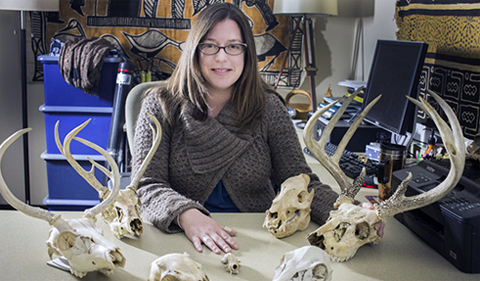
Dr. Sabrina Curran
Dr. Sabrina Curran, Assistant Professor of Anthropology, presents “Renewed explorations of the Mid-Pleistocene site, Isimila, Tanzania” at a joint meeting this month of the Paleoanthropology Society and American Association of Physical Anthropologists in Austin, Texas.
The Paleoanthropology Society was founded in 1992. It recognizes that paleoanthropology is multidisciplinary in nature and the organization’s central goal is to bring together physical anthropologists, archaeologists, paleontologists, geologists and a range of other researchers whose work has the potential to shed light on hominid behavioral and biological evolution.
The American Association of Physical Anthropologists is the world’s leading professional organization for physical anthropologists. Formed by 83 charter members in 1930, the AAPA now has an international membership of over 1,700. The Association’s annual meetings draw more than a thousand scientists and students from all over the world. Physical anthropology is a biological science that deals with the adaptations, variability, and evolution of human beings and their living and fossil relatives. Because it studies human biology in the context of human culture and behavior, physical anthropology is also a social science.
Curran’s article is co-authored by Dr. Paul Patton, Assistant Professor of Anthropology, and Dr. Cassy Mtelela, Lecturer of Geology at the University of Dar es Salaam.
Abstract: Isimila, located in central Tanzania, is well-known for its vast assemblage of Acheulean tools, where hand axes exist in densities similar to Olorgesailie, Kenya. Most of the work conducted at Isimila occurred in the 1960s and ’70s, and though the site currently exists as a tourist destination, there has been little archaeological work there in the past few decades. Originally dated to 260,000 years ago (Howell, 1972), there are indications that Isimila may be older. Here we r
Fossils were found both in and ex situ contexts. In situ fossils are very well-preserved and include partial pelvis, vertebrae, and dental remains, including a large tusk. Ex situ fossils in variable stages of preservation numbered in the hundreds. In situ fossils had very little bone surface modification, while ex situ specimens were in weathering stages 0-4, had limited carnivore damage, and exhibited some polishing, suggesting that they may have been deposited in fluvial or lacustrine contexts. Most fossils were assigned to Hippopotamus, although specimens of turtle and crocodile (both previously unreported), suid (Kolpochoerus), and bovid were recovered. Thus, the potential for finding further fossil material is high. Further, preliminary taphonomic assessment of new fossils revealed two specimens with likely cut-marks. Despite the abundance of stone tools at the site, these are the first reported cut-marks on fossils from Isimila.
Acknowledgements: We thank the Tanzania Commission for Science and Technology, Mohammed Ngoma, Joseph Temu and the Department of Antiquities, Nancy Stevens, and Patrick O’Connor. This research was funded by the Ohio University Research Council and Ohio University’s International Travel Fund.
References: Howell, F. Clark, Glen H. Cole, Maxine R. Kleindienst, Barney J. Szabo, and Kenneth P. Oakley (1972) Uranium-series Dating of Bone from the Isimila Prehistoric Site, Tanzania. Nature 237:51-52.



















Comments